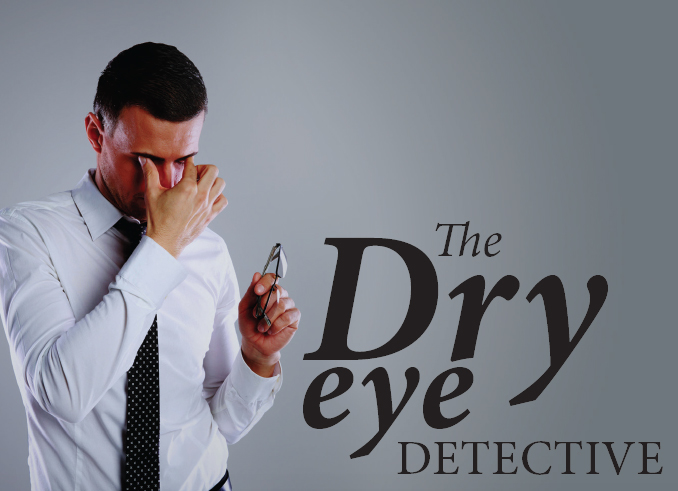 By Shirley Ha, HBSc, OD, FCOVD
By Shirley Ha, HBSc, OD, FCOVD
It is a little-known fact Sir Arthur Conan Doyle was an ophthalmologist before he gave Sherlock Holmes to the world. Doyle created a hero who was very adept at gathering evidence and using deductive reasoning and science to solve his cases. Like the greatest investigator in detective fiction history, eyecare professionals (ECPs) are detectives when caring for their patients’ eye and vision care needs, from organizing clinical data to diagnosing and managing conditions ranging from retinal diseases to contact lens-related dry eye symptoms.
Not all patients can wear contact lenses and not all contact lens wearers can wear them successfully. In fact, nearly 50 per cent of contact lens wearers drop out, citing discomfort as their primary reason1. According to Nichols et al., as many as 52 per cent of wearers encounter dry eye symptoms2. At its recent symposium, the International Society for Contact Lens Research (ISCLR) proposed meibomian gland dysfunction (MGD) – both obvious and non-obvious – and lid wiper epitheliopathy (LWE) as major contributors to contact lens discomfort and discontinuance. Nevertheless, ECPs are resolved that a good diagnostic workup and early detection and management can build up wearing time and increase the biocompatibility between the contact lenses and the ocular environment.
In general, dry eye is a complex condition and diagnosing it is not as elementary as it might seem. Some patients have clinical signs without symptoms while others are symptomatic and have few or no clinical signs. Here are some key steps to follow when contact lens patients present with dry eye symptoms.
Background Check
A detailed patient history is crucial to determine whether an existing, concomitant dry eye condition that is not related to contact lens wear might be contributing to the patient’s discomfort.
The causes of dry eyes are numerous. They may include, but are not limited to, systemic diseases (acne rosacea, rheumatoid arthritis, Sjogren’s syndrome), medications (diuretics, antihistamines, oral contraceptives), the environment (humidity, sun, wind), age/gender (hormonal changes), poor diet and social habits (alcohol, smoking). Beginning or resuming contact lens wear without addressing these causative factors will exacerbate dry eye irritation and symptoms.
Formal Interviews
Use standardized dry eye questionnaires such as the Ocular Surface Disease Index (OSDI), the McMonnies questionnaire or the Standard Patient Evaluation of Eye Dryness (SPEED) to assess the severity of the symptoms when the lenses are in the eyes, taking into account LWE and MGD symptoms of itchiness and morning discharge, any reduction in the frequency of wearing the lenses and the impact on the patient’s daily life.
The Usual Suspects
Look for evidence of MGD and evert every upper palpebral conjunctiva for evidence of LWE before starting contact lens wear and during all progress checks.
Also rule out other conditions that are predictive of or can contribute to dry eye problems, such as exposure keratitis, corneal dystrophies, allergic conjunctivitis, Bitot’s spots, conjunctival parallel folds, abnormal blink pattern and rate, including allergic responses to the contact lens material, the lens care solution or lens surface biofilm.
Other contributors to dry eye problems include improper lens fit, lens design and material, poor hygiene, not adhering to the wearing schedule and non-compliance with the cleaning regime.
The Forensic Tools
All contact lenses disrupt the pre-corneal tear film and can become adverse ocular irritants, and any unstable or abnormal pre-corneal tear film can make contact lens wearing intolerable, leading to drop out.
In some patients, both the quality and quantity of this tear layer are crucial in determining whether contact lens wear will be successful or if it should be avoided altogether. Auxiliary testing procedures such as the Schirmer and the phenol red thread test measure the quantity/volume of tears produced. The quality of the tear film is assessed by observing the lipid layer, the tear break-up time (TBUT), and the amount of debris in the tear meniscus and its speed of travel.
Staining tests or strips such as sodium fluorescein, rose bengal or lissamine green provide information about the integrity of the pre-corneal, corneal and conjunctival surfaces. For moderate-to-severe dry-eye conditions, further workup such as tear film osmolarity, lysozyme activity assay and tear glucose tests can also be considered.
The Road to Comfort
Eliminating contact lens-related dry eye symptoms poses many challenges. Every contact lens wearer will encounter dry eye symptoms at some point in their wearing lifetime. This is because patients are unique individuals with constantly changing ocular surfaces, depending on their work habits, environment, intrinsic issues (such as hormones, stress and lack of sleep), varying blink rates and tear chemistry. It is important to keep abreast of new research to better understand the dry eye disease and recognize the signs and symptoms of dry eyes in wearers in order to diagnose them accurately before they express contact lens intolerance and drop out.
- RUMPAKIS, J. “New Data on Contact Lens Dropouts: An International Perspective”, Review of Optometry, vol. 147, January 2010, p. 37-42
- NICHOLS J.J., ZIEGLER C., MITCHELL G.L., NICHOLS K.K. “Self-Reported Dry Eye Disease across Refractive of Modalities, Investigative Ophthalmology & Visual Science, vol. 46, June 2005, p. 1911-14.







